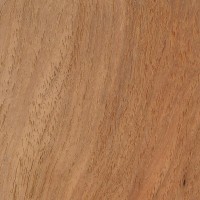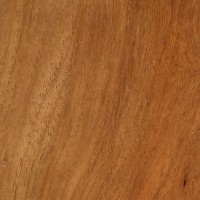 |
Common Name(s): Narra, Amboyna (burl) Scientific Name: Pterocarpus indicus Distribution: Southeast Asia Tree Size: 65-100 ft (20-30 m) tall, 3-5 ft (1-1.5 m) trunk diameter Average Dried Weight: 41 lbs/ft3 (655 kg/m3) Specific Gravity (Basic, 12% MC): .54, .66 Janka Hardness: 1,260 lbf (5,620 N) Modulus of Rupture: 13,970 lbf/in2 (96.3 MPa) Elastic Modulus: 1,724,000 lbf/in2 (11.89 GPa) Crushing Strength: 8,270 lbf/in2 (57.0 MPa) Shrinkage: Radial: 2.8%, Tangential: 4.0%, Volumetric: 6.9%, T/R Ratio: 1.4 |
Color/Appearance: Heartwood can vary widely in color, ranging from a golden yellow to a reddish brown. Pale yellow sapwood is clearly demarcated from the heartwood. Quartersawn surfaces display ribbon-stripe figure, and the wood is also seen with mottled, beeswing, or curly figure. Narra burl is full of well-defined knot clusters, and the highly valued wood is known as Amboyna.
Grain/Texture: Grain is usually interlocked, and can sometimes be wavy. With an uneven medium to coarse texture with good natural luster.
Endgrain: Semi-ring-porous; solitary and radial multiples and clusters; very large pores grading down to large/medium pores, very few; mineral/gum deposits (reddish brown) common; parenchyma vasicentric, winged, confluent, and banded; narrow rays, normal to close spacing.
Rot Resistance: Narra has good weathering characteristics and is typically very durable regarding decay resistance. It is generally resistant to termite and powder post beetle attack, though there can occasionally be ambrosia beetles present, especially in the sapwood.
Workability: Easy to work with both hand and machine tools, one of Narra’s only downsides is that it has a moderate blunting effect on cutters. Narra turns, glues, and finishes well.
Odor: Narra has a distinct fragrance that lingers even after being worked.
Allergies/Toxicity: Although severe reactions are quite uncommon, Narra has been reported as an irritant; most common reactions simply include skin and respiratory irritation, as well as asthma-like symptoms. See the articles Wood Allergies and Toxicity and Wood Dust Safety for more information.
Pricing/Availability: Not commonly exported as lumber, smaller pieces of figured Narra are sometimes available from specialty wood retailers, as well as Amboyna burl in solid and veneer form. Prices vary depending on the amount and type of figure: unfigured wood is moderately priced, while high-grade Ambyona ranks as one of the most expensive woods in the world.
Sustainability: This wood species is not listed in the CITES Appendices, but is on the IUCN Red List. It is listed as vulnerable due to a population reduction of over 20% in the past three generations, caused primarily by exploitation.
Common Uses: Veneer, furniture, cabinetry, boatbuilding, plywood, turned objects, and small specialty wood items.
Comments: This wood has a seeming split personality. One the one hand there is the humble Narra, with good workability and dimensional stability (much like other members of the Pterocarpus genus)—on the other hand there is the exotic and highly-prized burl wood known as Amboyna. Both come from the same tree (Pterocarpus indicus), though the resemblance between the two is virtually unrecognizable.








It does have a certain smell to it. Its beautiful wood and if you have the tree on your property in the Philippines. You will need a permit from the government to cut it down. Since it is their national tree.
Is Narra wood suitable for kitchen cabinets. Our exixting cabinets eaten by termites, in The Philippines. Will it be ideal to use against Termites
Keating and Bolza report in Characteristics, Properties and Uses of Timbers of South-east Asia, Northern Australia, and the Pacific that narra is “resistant to termite attack.” I think the only issue would be ensuring that you have 100% heartwood with no sapwood, as the sapwood would be prone to insect damage, while the darker colored heartwood would not.
Probably not. It is relatively soft – which means they will attack it, and it has not oils or sap that repels them. Try using Kwila or Merbau, although it is hard and heavier wood, termites will first look for softer woods before attacking the hardwoods.
This is a beautiful wood and I have several pieces from Papua New Guinea. I turned a couple of handles from it and I also used some in a cutting board (the two strips in the middle).
I live in the Philippines and here we have a beautiful hardwood called molave or tugas. Do you know anything about it?
What wood stain is good for this?
When you make a wood craft like puddle. of typed narra wood quality.for mixing candy. It is not danger in health.. Plsss answer me if you know the exactly answer
Are you asking if you should make a paddle for mixing candy? Would this include high temperatures? I’d be careful in choosing woods that will be immersed in hot liquids.
When soaked in tap water for about half an hour, Narra wood leaves a yellowish coloration in the water (the resultant water coloration may be somewhat like gasoline or diesel fuel). Sometimes, more deeper yellow coloration, if soaked in water for longer periods of time. I am not certain if how will it be, if Narra is soaked in water with other chemicals or food ingredients. With this, I am not sure if this is safe, given that you plan to use it in mixing food – like candies. However, if this coloration is important for you on the resultant… Read more »
Narra wood is not that strong when soaked to water. The best is Yakal wood , based on our experience, there was a very old bridge we demolished in Batangas we found out that the base was yakal wood. It really stands the test of time.